10.1 Chord Voicing and Part Writing, General Principles: Tutorial
Voicing and Voice Leading Principles
Chapter 9 discussed the qualities that make a good melody and how those qualities are translated to music. When you combine more than one melody you take both the melodic (horizontal) and harmonic (vertical) elements into account in order to create smooth, pleasing lines.
In chapter 5, we learned how to build and recognize triads and seventh chords. Now, we will focus on learning how to connect chords through voice leading. We will be exploring voice leading and part writing by learning to build chords vertically and connect them together horizontally in a four-voice texture. Through this process we will learn how music works, how it is structured, what makes it sound good, and what makes it move forward.
To learn the process of voice leading we will be working in 4 voice texture comprised of a soprano, alto, tenor, and bass voice (SATB). Four voices are necessary so that each chord member can be present to have complete chords. This is especially important for seventh chords, which have four chord members. Using four voices provides fullness of sound without losing clarity, so that each voice can be heard. Writing in four voice texture allows us to consider voice leading between chords in a melodic (horizontal) way in order to create a singable melody in each voice. Writing for four voices also allows us to limit our range so that it corresponds to the ranges of voices, rather than the more expansive ranges of different instruments. That also means that all voices will be in the same key, without the need to transpose lines to work with instruments pitched in different keys. Writing in four voice texture also gives us the ability to easily sing part writing examples and compositions.
Voicing Chords in Four Voices (SATB)
Stem direction: In order to easily be able to tell voices apart and see their motion on the staff, each voice uses a specific stem direction.
- Soprano: stems up
- Alto: stems down
- Tenor: stems up
- Bass: stems down
Spacing: Adjacent pairs of upper voices must remain within an octave of each other.
- Soprano and alto stay within an octave of each other.
- Alto and tenor stay within an octave of each other.
- The bass is the only exception. It can be more than an octave from the tenor. The bass needs freedom to move to fulfill its harmonic role in a melodic way.
Range: each voice has a range that should not be exceeded. However, the bass voice can move a bit more freely to expand the range by a few notes.

Doubling: when writing a three-note triad in four voices, one of the voices must be doubled. Use this general guide when doubling notes in each type of chord. Doubling for the different types of chords will be discussed in greater detail in the sections on part writing with root position chords, chords in inversion, and seventh chords.
- Do not double tendency tones (leading tone, altered tones, the chordal seventh of a seventh chord)
- Root position chords:
- Major and minor chords: double the root (the bass)
- Exception: V-vi: most often doubles the 3rd of the vi chord
- Diminished chords: double the 3rd of the chord
- Major and minor chords: double the root (the bass)
- First inversion chords:
- Major and minor triads: double anything except the leading tone or tendency tones
- Diminished chords: double the 3rd of the chord
- Second inversion chords:
- double the bass (the 5th of the chord)
Melodic Principles for Voice Leading (Connecting Chords)
These principles apply to each voice in order to produce melodic lines that are likely to be musical and singable.
Motion:
- Move each voice primarily by sustained or stepwise motion. Sustained motion between chords (using common tones) are always a good choice to connect chords.
- If no common tones are possible between chords, move each note in contrary motion to the bass. Use stepwise motion when possible.
- Use contrary and oblique motion instead of parallel motion between voices (when possible) in order to create strong counterpoint between voices.
Chromatic intervals:
- Do not use augmented/diminished intervals melodically.
- Watch out specifically for the augmented 2nd that can occur between scale degrees 6 and 7 in minor as a result of raising the leading tone.
Leaps:
- Use leaps larger than a 5th sparingly.
- Follow all leaps larger than a 3rd with stepwise motion in the opposite direction when possible.
- Successive melodic leaps in the same direction should arpeggiate the underlying harmony (the bass has more freedom).
- Avoid leaps in 3 or more voices, especially in the same direction.
Resolve tendency tones:
- The leading tone resolves to tonic.
- The chordal seventh of a seventh chord resolves down by step.
- Altered tones resolve by step in the direction of the chromatic inflection (raised note resolve up, lowered notes resolve down).
Part Writing Errors
Following the guidelines outlined above for correctly voicing and connecting chords through melodic motion can help avoid many part writing errors, but does not guarantee the absence of errors between chords. Errors often occur between certain chords that have connections that must be handled carefully, or when certain chords do not move well to other chords. Knowing the types of errors that can result during part writing is essential so that they can be corrected in order to create a better chord progression. When writing in four voices, always check each chord and each chord connection for the following list of potential errors.
All chords spelled correctly:
- Make sure all chord members or spelled correctly and are in the correct inversion.
- Remember to raise the leading tone in minor in V and vii˚ chords.
Leap errors:
- Leaps over a 5th and dissonant leaps (A2, TT, 7ths, etc.)
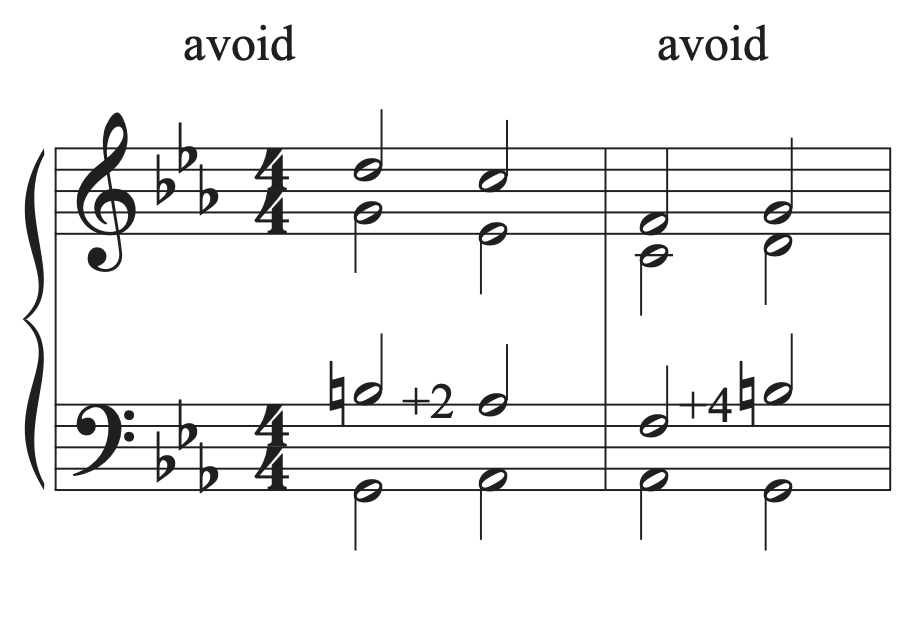
- Leaps in 3 or more voices, especially in the same direction
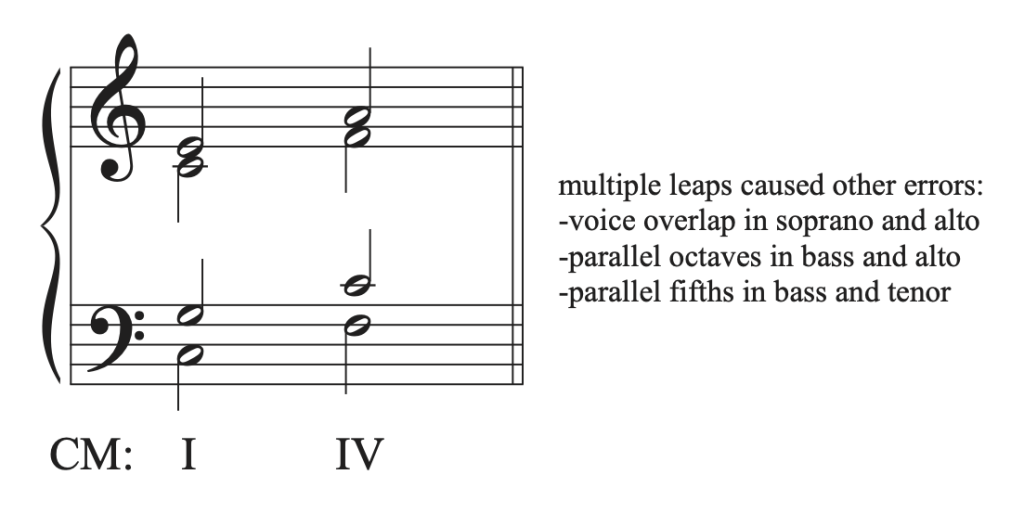
- Large leaps (4th or more) not resolved in the opposite direction

- Consecutive leaps in the same voice, in the same direction, not outlining a triad
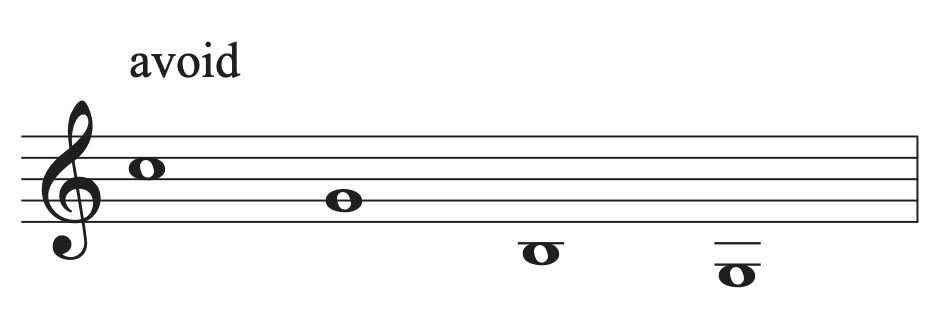
Spacing errors:
- Keep adjacent voices within an octave of each other (exception: bass may be more than an octave below tenor).
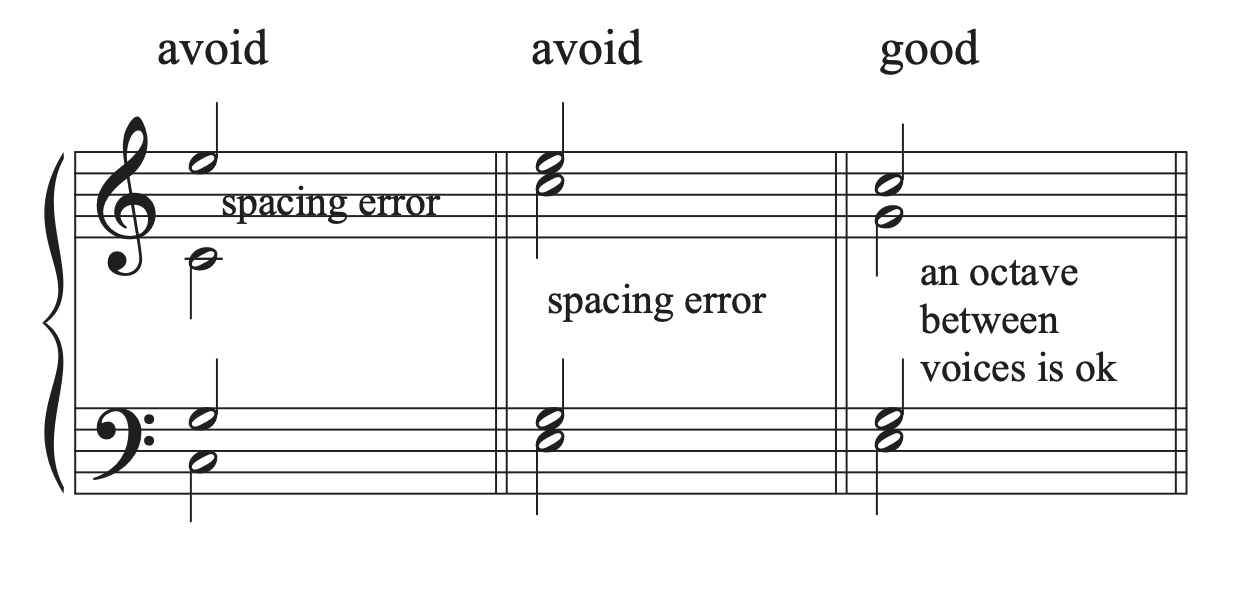
- Voice crossing: when adjacent voices cross positions on the staff (ex: alto moving below tenor’s pitch in same chord)
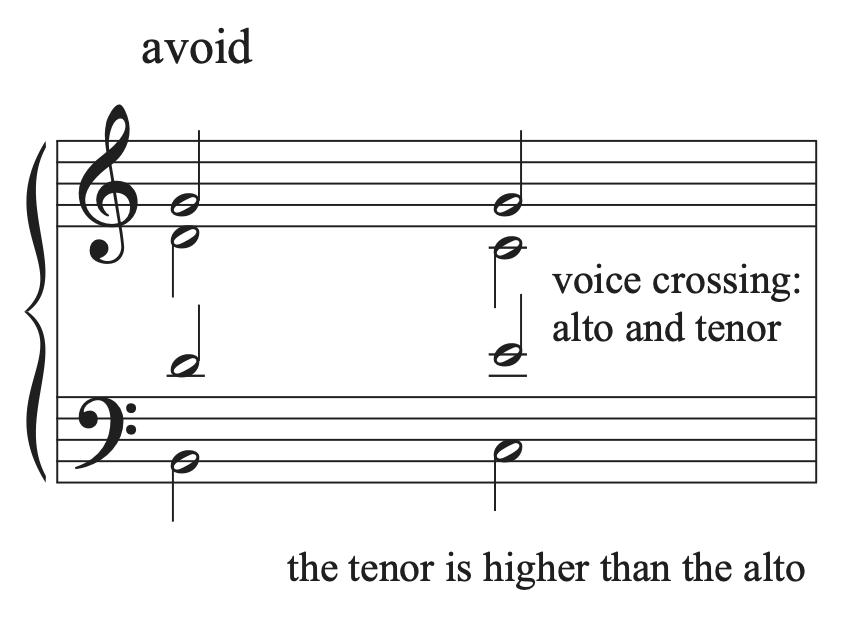
- Voice overlap: when one voice moves higher or lower than an adjacent voice was on the previous chord (ex: alto moving above the soprano’s pitch in the previous chord)
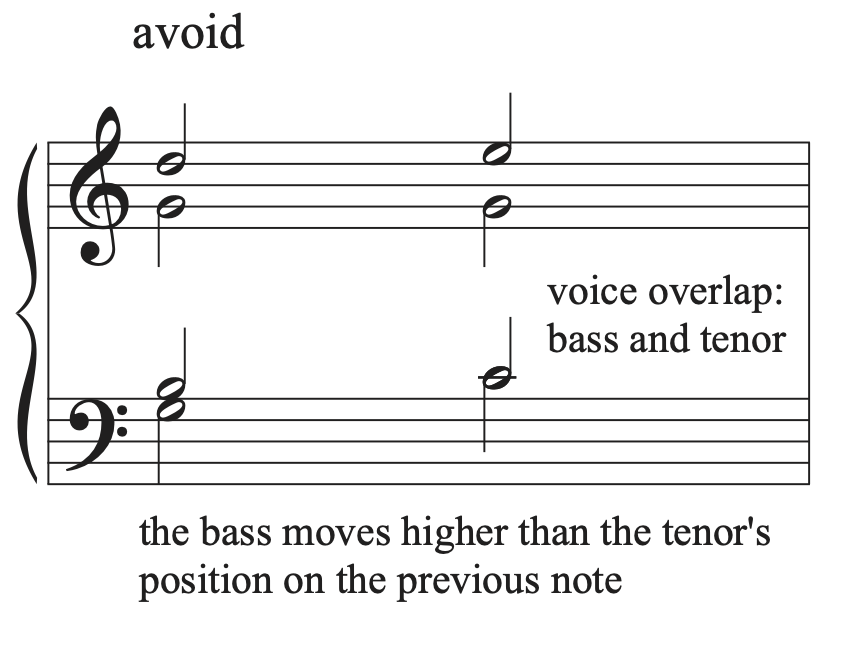
- Voices exceeding their range. Remember that the bass has a little more flexibility to extend a few notes beyond this range.

Motion errors:
- Similar motion in all voices
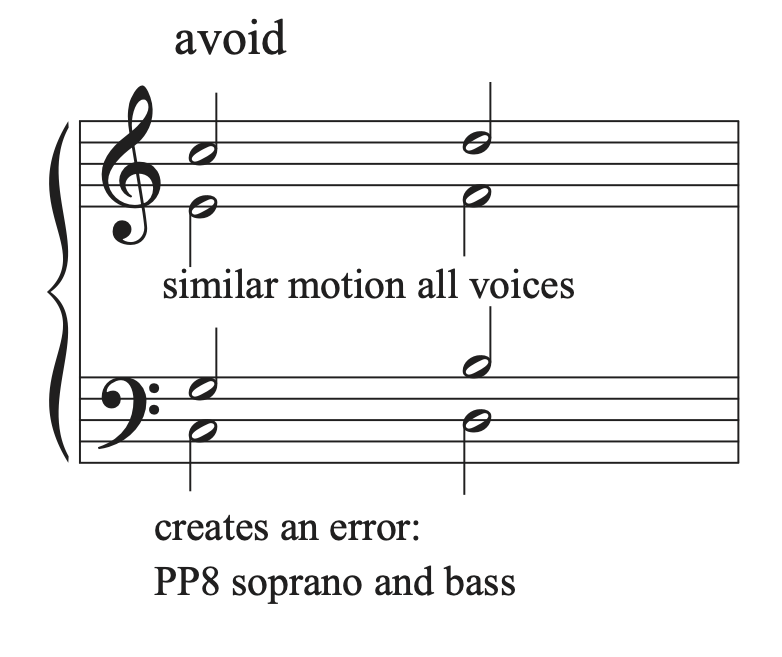
- Parallel 5ths (PP5), Parallel octaves (PP8), Parallel unisons (PPU)
- Voices move from a P5, P8, or PU to the same interval using similar motion
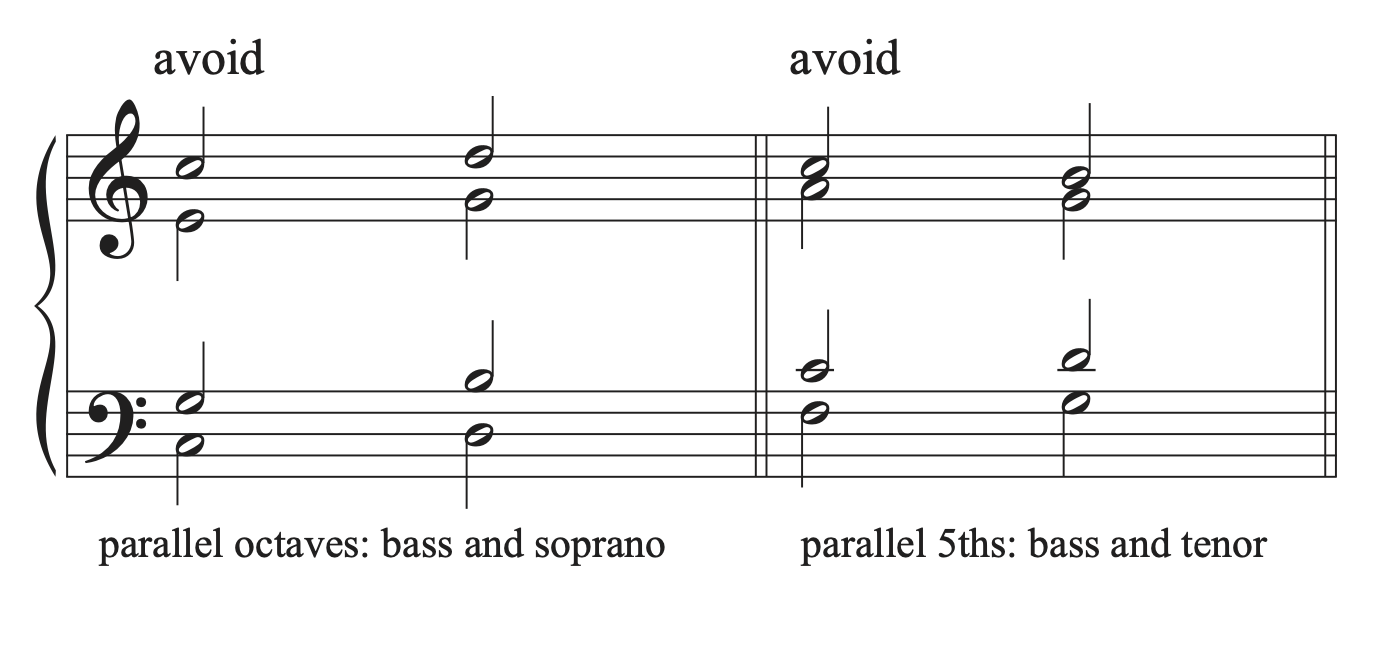
- Contrary 5ths (C5), Contrary octaves (C8), Contrary unisons (CU)
- Voices move from a P5, P8, or PU to the same interval using contrary motion
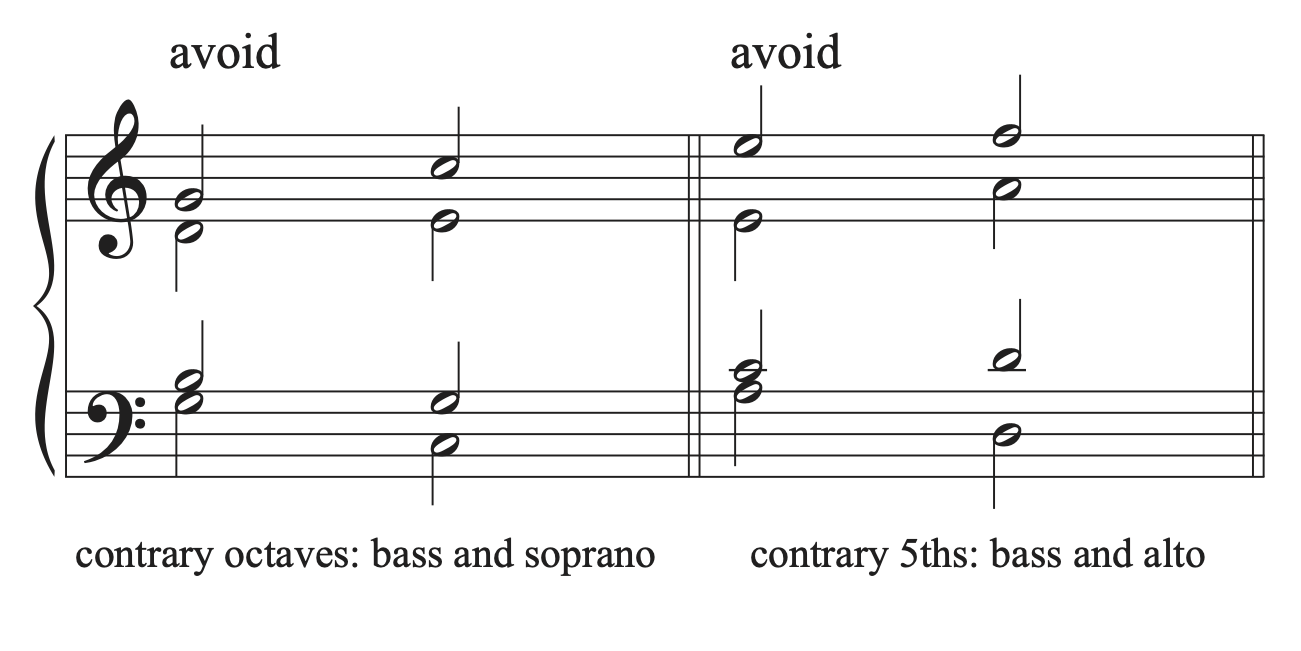
- Direct 5ths (D5), Direct octaves (D8)
- When the bass and soprano voices move in similar motion from any interval to a P5 or P8 and the soprano leaps.
- This an error only when the intervals are created between the bass and soprano voices.
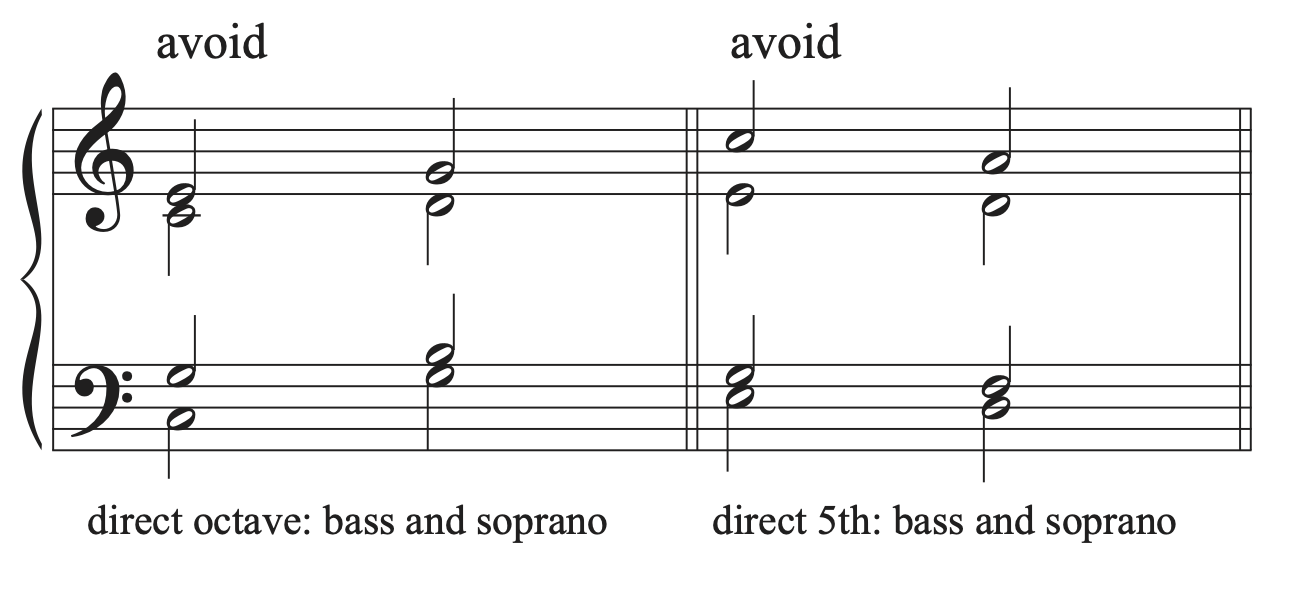
- Unequal 5ths
- When the bass and an upper voice move from a diminished 5th to a Perfect 5th in similar motion, it is an unequal 5th.
- This is an error only when the intervals are created between the bass voice and another voice.

Leading Tone errors:
- The leading tone should most often be raised in minor on V and vii˚ chords.
- The leading tone should resolve to tonic. If it is in the soprano, it has to resolve to tonic. If it is in the inner voices, it can resolve down to scale degree 5, but it is better to resolve it to tonic when possible. If it is in the bass voice, it can transfer to another voice if the chord changes to another dominant function chord with a leading tone. The leading tone then resolves in the new voice in the next chord.
Doubling errors:
- Do not double tendency tones (Leading tone, altered tones, 7th in a 7th chord)
- Root position chords:
- Major and minor chords: double the root (the bass)
- Exception: V-vi: double the 3rd in the vi chord
- Diminished chords: double the 3rd
- Major and minor chords: double the root (the bass)
- First inversion chords:
- Major and minor triads: double anything except the leading tone and tendency tones.
- Diminished chords: double bass (the 3rd)
- Second inversion chords:
- Double the bass (the 5th)
Summary of voice leading principles and part writing guidelines
- Connect chords horizontally through good melodic motion as well as vertically.
- Each voice in SATB part writing uses a specific stem direction.
- To help avoid part writing errors: build chords with correct spacing, staying within the designated voice ranges.
- Memorize the part writing guidelines for doubling, spacing, leaps, and motion between chords. These will help you avoid creating part writing errors.
- Memorize the possible part writing errors and make it a habit to check for errors on every chord and between every two chords in a progression.

